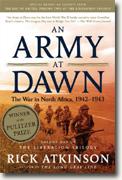An Army at Dawn
Rick Atkinson
book reviews:
· general fiction
· chick lit/romance
· sci-fi/fantasy
· graphic novels
· nonfiction
· audio books
· author interviews
· children's books @
curledupkids.com
· DVD reviews @
curledupdvd.com
newsletter
win books
buy online
links
home
for authors
& publishers
for reviewers

 |
An Army at Dawn: The War in North Africa, 1942-1943, Volume One of the Liberation Trilogy Rick Atkinson Henry Holt Paperback 768 pages May 2007 |
|
Not much is widely understood about the battle for North Africa in World War II. To many, it consists of one battle: Kasserine Pass. Here, the American army had its first taste of defeat. They learned a lot from this defeat, though, and carried those lessons on to Italy and to the invasion of France. Never again were they defeated to any great extent. This understanding is hopelessly incomplete, as there were many defeats in this campaign before the Allies finally disposed of the German presence on North African soil.
North Africa was the crucible for the American army. From a young, inexperienced force that had never seen battle before, the U.S. army went through the fires of numerous battles in places never heard of and places that would never be heard of again (such as Sidi bou Zid, Sidi el Moudjad, and so forth) and emerged a tough fighting unit. Bloodied, sometimes broken, eventually the army became forged as tough as steel. While this book is a comprehensive history of the North African campaign, one of the major themes of the book (hence the title) is the transformation of the American army from a green force to a tough fighting machine. There are numerous passages in the book where Atkinson talks about the British feelings about this new upstart army, and how it would never amount to anything. British Field Marshal Montgomery was very disdainful of it, saying that they didnít know how to fight and never would. He would be proved wrong. Atkinsonís writing draws the reader into the action. He wastes no words but provides vivid descriptions of the action. At times he is quite graphic, talking about how a tank shell decapitated somebody or how a soldier is lying on the ground trying to keep his insides from falling out. He sometimes falls into the trap of melodrama, though, such as on page 76 when he says: ďFar above, at the shrine of Notre Dame de Santa Cruz, a weathered stone madonna extended her hand toward the harbor, as if to offer absolution for all that she had witnessed.Ē Lines like these are sprinkled throughout the text and get a little annoying after awhile. However, they donít detract from how successful Atkinson is in getting across to the reader what is happening. He makes the book hard to put down. An Army at Dawn One other minor problem is the emphasis on the negative when Atkinson is talking about the quieter times. I consider it a plus that Atkinson pulls no punches in telling the reader about the bad things that happened during this time. Heís honest about the fact that the American fighting man, for the most part, was not ready for this war. Many ran, or died due to the incompetence of their leaders. He also talks about some valorous actions taken by the troops. But when Atkinson talks about things taking place behind the lines, he tends to concentrate on the negative. He talks about the treatment of the Arabs, how some of the women were raped or brutalized in other ways. That story does need to be told, but he never talks about any good things that the troops may have done. Iím sure there must have been some good things that he could have talked about, such as an American soldier protecting a family or giving them some food, or something. Iím not quite sure why he avoids this, but I did find that detracted from my enjoyment. Overall, I have to heartily recommend An Army at Dawn Originally published on Curled Up With A Good Book at www.curledup.com. © David Roy, 2007 |
| Also by Rick Atkinson: |
|
|
|
 Click here to learn more about this month's sponsor! |
|
| fiction · sf/f · comic books · nonfiction · audio newsletter · free book contest · buy books online review index · links · · authors & publishers reviewers |
|
| site by ELBO Computing Resources, Inc. | |
